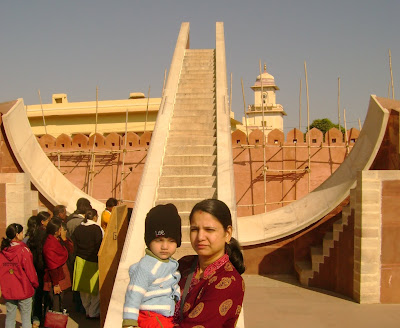


A quick guide to the specific use of the curious instruments in Yantra Mandir (as depicted at Jantar Mantar, Jaipur, Rajathan):
The Ram Yantra can measure the local coordinates of altitude and azimuth of celestial objects.
Jai Prakash Yantra is used to find the positions of the celestial bodies during day and night..
The Dhruva Yantra is used to locate the position of 12 Zodiac signs and also the Pole Star at night.
The Narivalya Yantra is a distinctive sundial with two dials - the first dial facing south reads time when the sun is in the southern hemisphere, i.e., from 21 September to 21 March and the other one facing north reads time for the rest of the year when the sun is in the northern hemisphere, i.e., from 21 March to 21 September.
The Krantivrtta is an instrument that is meant to measure the celestial latitude and celestial longitude of an object in the sky. It is also used for measuring solar sign of the Sun in day time.
The Yantra Raj is an adaptation of an Astrolabe - a Medieval instrument for the measurement of time and the position of celestial objects.
The instrument is used for measuring ascendants, altitude, time and the position of the Sun and that of some other celestial objects in the sky. It can also be used in the computation of celestial positions and their changes. The instrument also measures time from the positions of stars in the night, and that of the Sun in the day.
Unnatamsa for measuring altitude - the angular height of an object in the sky.
Chakra yantra gives the angle of an object from the equator.
Disha yantra or the compass always points to the north.
Dakshinottra Bhitti measures the altitude of the angular height of a celestial object when it crosses the meridian.
Laghu Samrat Yantra is a sundial that can give the time to an accuracy of 20 seconds.
Rashivalayas Yantra has 12 sundials for the signs of the zodiac.
Note: The traditional unit of measurement started with the smallest unit being 'human breath' that has been calculated to be of 6 seconds duration.
These structures remind us of the role of light and time in our everyday life !
No comments:
Post a Comment